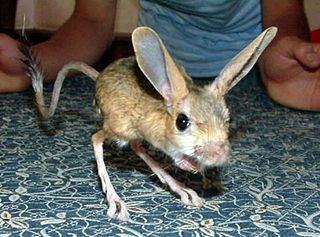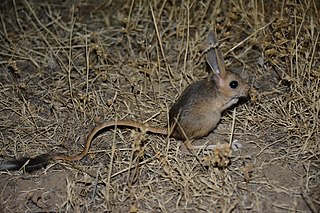| Allactaginae Temporal range: Middle Miocene - Recent | |
|---|---|
 | |
| Allactaga elater | |
| Scientific classification | |
| Kingdom: | Animalia |
| Phylum: | Chordata |
| Class: | Mammalia |
| Order: | Rodentia |
| Family: | Dipodidae |
| Subfamily: | Allactaginae Vinogradov, 1925 |
| Genera | |
| Allactaginae Temporal range: Middle Miocene - Recent | |
|---|---|
 | |
| Allactaga elater | |
| Scientific classification | |
| Kingdom: | Animalia |
| Phylum: | Chordata |
| Class: | Mammalia |
| Order: | Rodentia |
| Family: | Dipodidae |
| Subfamily: | Allactaginae Vinogradov, 1925 |
| Genera | |
Subfamily Allactaginae
The cladogram below is based on a 2022 phylogenetic study of the nuclear genes by Lebedev et al. [1]
| |||||||||||||||||||||||||||||||||||||||||||||||||||||||||||||||||||||||||||||||||||||

Jerboas are hopping desert rodents found throughout North Africa and Asia, and are members of the family Dipodidae. They tend to live in hot deserts.

The four-toed jerboa is a rodent of the family Dipodidae and genus Scarturus that has four digits. Four-toed jerboas are native to Egypt and Libya. They live in coastal salt marshes and dry deserts.

Dipodoidea is a superfamily of rodents, also known as dipodoids, found across the Northern Hemisphere. This superfamily includes over 50 species among the 16 genera in 3 families. They include the jerboas, jumping mice, and birch mice. Different species are found in grassland, deserts, and forests. They are all capable of saltation, a feature that is most highly evolved in the desert-dwelling jerboas.

The genus Allactaga contains the five-toed jerboas of Asia. They are small mammals belonging to the order of rodents. They are characteristically known as the hopping rodents of the desert and semi-arid regions. They have long hind feet, short forelimbs, and walk upright. They have large ears in comparison to their body size and a large tail. The tail assists and serves as support when the jerboa is standing upright. The jerboa body length ranges from 5–15 cm and has a tail ranging from 7–25 cm. The "forelimbs of the jerboa serve as a pair of hands for feeding, grooming, etc." Jerboas use their nose to burrow and push the dirt when looking for food. The male jerboa is usually larger in size and weight in comparison to the female jerboa. The pelt of the jerboa is either silky or velvety in texture and light in color, the coloration helps camouflage into surroundings to avoid predators. All members of the genus have five toes except for a single species, the Four-toed Jerboa, Allactaga tetradactyla of Northern Africa.
The Iranian jerboa is a rodent of the family Dipodidae and subfamily Allactaginae. They are characteristically known as hopping rodents and have only been found in a small population in Iran. Iranian jerboa are microhabitat specialist, they require a particular environment to provide them with specific conditions suitable for living.
The Gobi jerboa is a species of rodent in the family Dipodidae. It is found in China and Mongolia. Its natural habitats are temperate grassland and temperate desert.

The small five-toed jerboa is a rodent of the family Dipodidae and genus Scarturus, that has five digits. They are hopping rodents of the rocky deserts in Asia. They have been found in Afghanistan, Armenia, Azerbaijan, China, Georgia, Iran, Kazakhstan, Pakistan, Russia, Tajikistan, Turkey, and Turkmenistan. They have long hind feet, short forelimbs, and walk upright. The jerboa body length ranges from 5–15 cm and has a tail ranging from 7–25 cm. They have large ears in comparison to their body size and a large tail. The tail assists and serves as support when the jerboa is standing upright. These hopping rodents can reach a speed up to 48 km/hr. The forelimbs of the jerboa serve as a pair of hands for feeding, grooming, etc. The male jerboa is usually larger in size and weight in comparison to the female jerboa. The pelt of the jerboa is either silky or velvety in texture and light in color, the coloration helps camouflage into surroundings to avoid predators. "Its coloration varies from sandy or buff to dark russet or black with pale under parts and a white strip on the hip”.
The Euphrates jerboa is a rodent of the family Dipodidae and genus Scarturus. They are characteristically known as hopping rodents. They have been found in Pakistan, Afghanistan, Iran, Iraq, Jordan, Kuwait, Saudi Arabia, Syria, and also occurs very marginally in southeastern Turkey. The Euphrates jerboa's natural habitats are semi-deserts, subtropical or tropical dry lowland grassland and hot deserts.
Pygeretmus is a genus of rodent in the family Dipodidae. It contains the following species:

Williams's jerboa is a species of jerboas native to Afghanistan, Armenia, Azerbaijan, Iran and Turkey.

Cardiocraniinae is a subfamily of rodents in the family Dipodidae, named by the Russian zoologist Boris Stepanovich Vinogradov (1891–1958) in 1925. These jumping rodents are small mammals, less than 20 cm long.